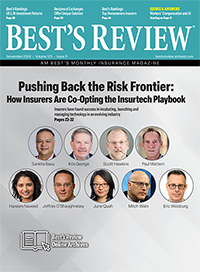Startups: Executive Interview
A Combined Approach
Startupbootcamp InsurTech’s VanderLinden: Insurers must implement incremental innovation and disruptive innovation at the same time.
Sabine VanderLinden, CEO, Startupbootcamp InsurTech, said most of the startups she's seeing currently are designed to collaborate with large enterprises, rather than build stand-alone operations. VanderLinden spoke with AMBestTV at InsureTech Connect 2018, held in Las Vegas.
How is insurtech of today different than insurtech of the past?
When you look at today's insurtech startups, I would say they are more mature. When we started in 2015, it was just a few startups which came to market. And during that year, we talked to 1,500 startups. My team here, just in the U.S., has talked to about 3,300 startups. What you find is volume, more startups. Then when you look at the type of things they are doing, when we started in 2015, it was all about retail, developing products and services for the travel, home, car insurance markets, improving that customer engagement. Probably 60% of the startups we sourced during that year were customer engagement startups. Today, the startups are going down the value chain, moving to more complex areas of that value chain, such as underwriting and AI, and looking at new ways to service customers, but also sectors. Complex type of insurances, such as specialty lines and commercial lines. Now, we are seeing more and more life, health and annuity startups coming to market. More complex, more interesting areas of the value chain. Startups, which are also coming from other adjacent areas of the industry, may enrich an insurance data pool to design new, personalized products and services.
How has the industry's view of insurtech startups changed?
Today, the startups are going down the value chain, moving to more complex areas of that value chain, such as underwriting and AI, and looking at new ways to service customers, but also sectors.
When we started, it was all about curiosity, observing. Everybody talked about the new disruptor coming into the industry. They didn’t really know how to approach it. Now, the conversation is different; 80% of the startups which are out there need to collaborate with large enterprises, so they are part of an ecosystem of players which are aiming to improve and ensure ecosystem capabilities. I would say the relationship is a much more co-creative one, one where different players have the ability to add value. I think what we are seeing more and more is that insurance may be starting in retail, insurance may be starting in manufacturing or transportation, because that is where the relationship is starting. What we will see as well is a new business model coming to market.
Is disruption from within possible, and if so, what is the key to that?
I believe that large organizations need to do a lot of work to disrupt themselves from within, but yes, it is possible. You have the big players, such as Munich Re and AXA, who have started doing that for many years. What they're doing is, like one of my market colleagues would say, developing ambidextrous strategies. What they mean by that is that a business, to be successful, needs to implement incremental innovation and disruptive innovation at the same time. Incremental, meaning that they have to work tactically with a few startups to design a solution and partner with them.
Also, learn to change their internal capability, so changing the way people work with startups, changing the way people bring new products and services to market. You cannot produce a product in 12 months anymore. You need to shrink that to eight to 12 weeks. How are you going to do that? You need to change your internal DNA. Then you have the disruptive side, which is about corporate venture capital and venture build, where you're going to acquire new talent from the outside to help you build completely new companies. You have to do that at the same time. The only way you can disrupt from within is by using different parts of the puzzle to make your company ready to be agile and flexible to meet the needs of the future.
Collaboration, partnerships, those are big topics this week. Is that a shift in thinking? Is the industry more willing to partner now than it has been in the past?
As an industry, there's still a lot of work to do. You have a lot of companies who still want to keep their hand close, because they don't want to invite partners from the outside. A lot are learning from what happened in fintech. Open innovation is key to succeed in today's world. By inviting players from the outside to help you innovate, but also to design products which are more relevant for customers of tomorrow require you to deliver and work amongst ecosystem players.
You probably won't have the choice. You will see the leaders and the followers, and the laggards emerging more and more in the next few years. Businesses now are disappearing every day. Those who want to sustain and survive will have to adapt the way they are working with the external world.
You not so long ago launched a program in Hartford, Connecticut. How is it growing?
That is growing very well. Yes, in September [2017] we launched a program in Hartford. It's amazing to have seen the community in Hartford supporting us in our venture.
We are working now with probably six of the largest insurers in the region at the moment. A lot of other insurers are asking us, “Can we participate? Can we help build this ecosystem?”
The goal is for Hartford to become the next insurtech capital in the U.S. We have a lot of work to do. We have to bring a lot of talent from the outside world, meaning from Europe, Asia, but also bringing and building talent, and new culture as well in the city of Hartford.
[We are] training new entrepreneurs, we have a new insurtech course being launched as well. It's about bringing all the different ingredients to attract talent, build innovators, and get Hartford to become an insurtech destination in the next few years.
Your London accelerator program has been very successful. It's received a lot of funding. If you had to pick one of your startups that's been the most successful, which one would it be?
I have many. There are a few which are here today. The one everybody talks about right now is BuzzVault, a new offering with Munich Re Digital Partners. What I like about BuzzVault is that it's a female founder team. That shows that woman can do great work in the industry.
I do believe that this startup is going to be amazing. Others would include massUp, which has been doing great work with Willis.
The last one is Valoo, which is a French startup, also focused on asset digitization, and which is working with Bâloise, for instance, outside of France.
Those are three of my babies. There are many more, many more, which I am sure you are going to see people talk about in the next few years.






















